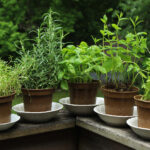It’s Earth Day this weekend!
To celebrate our Earthly Mother and all we gain from Nature, I want to continue our grow-at-home series from last week’s Grow Your Own Potatoes blog, which was a hit!
I love herbs! I’m a trained herbalist, and after my years of experience, I’m still in awe of these nutrient-dense powerhouse plants that grow so abundantly all over the planet.
Herbs are a potent gift that offer so much healing. Share on X
Find my top 5 grow-at-home herbs below!
THE HEALING POWER OF PLANTS
Many of us are familiar with the idea that plants possess healing benefits.
We hear about the antioxidants in berries and how they can revitalize our brain and liver and protect us from aging.
The mineral and protein-rich nutrition of leafy greens like spinach and arugula is widely accepted.
But some of the most powerful healing medicine on the planet grows wild in our backyards.
I’m talking about herbs!
Herbal medicine has been around for thousands of years. Long before we had medications, we had herbs.
Herbs offer some of the most potent healing benefits of the plant kingdom, and a little bit goes a long way!
One of my favorite things about herbs is how easy they are to grow at home! Especially for anyone trying to cut down costs for healing recipes while healing on a budget (did you see my 5 Tips for Healing on a Budget blog?).
To celebrate home gardening and Earth Day this weekend, I want to share my top 5 grow-at-home herbs with you with tips and tricks to get the most out of your herbal remedies.
What’s good for you is good for the planet. When we remove toxins from our environment, we not only protect our health and the health of our loved ones, we stop supporting industries who profit off of cheaply made toxic chemicals.
Get the full scoop with tips on how to detoxify your home, switch to toxin-free cosmetics brands, find your favorite natural cleaning products, and more in my GREENING YOUR HOME MASTERCLASS. Learn more here!
BORN TO BE WILD
Grow-at-home herbs stay connected to the full power of their wild cousins in Nature. Many herbs, like parsley and nettle, retain their wild nature even when grown in pots on kitchen counters or in balcony gardens.
Growing herbs at home is easy because wild plants are much more resilient! And they pass that resilience on to us when we consume them.
These top 5 grow-at-home herbs will satisfy your green thumb, even if you’re new to gardening. Your new herb garden will thrive with a bit of water and enough sunlight.
TOP 5 GROW-AT-HOME HERBS
Rosemary
Rosemary has been a medicinal herb for millennia, offering anti-inflammatory support for various conditions. Rosemary also acts as a natural antiseptic, disinfectant, antiviral remedy, antidepressant, and expectorant.
Rosemary can improve blood circulation, build the immune system, support digestion, alleviate nerve-related symptoms like rheumatoid arthritis and fibromyalgia, and act against viruses and bacteria. It can also help to combat asthma. Steam diffusing essential rosemary oil into your office or bedroom can kill airborne pathogens and purify the air.
Growing rosemary at home is easy as this is a very resilient herb. Pick up a healthy potted rosemary plant with firm dark leaves and transplant it into a larger pot at least once yearly as it grows. Before long, you’ll have a thriving source of plant medicine.
Planting outdoors at a distance from large shrubs or trees will also yield a large and abundant rosemary bush.
Rosemary does well in full sun but can tolerate some shade. Supplement your waterings with organic liquid or solid compost if growing in pots since nutrients can be flushed out of potting soil over time.
Thyme
Thyme is the cold and flu remedy we should reach for when any bug is going around. It’s a true pathogen-fighter, and benefits the entire body from head to toe. Thyme also has a calming effect on the whole nervous system and helps to protect against stress damage.
If you’re fatigued after getting over a rough case of the flu, a cold, or any virus, bring thyme into your daily routine to help get your energy back. Thyme is packed full of minerals, antioxidants, and phytochemicals that benefit every system in our bodies.
Thyme tea using sprigs straight from the garden is my go-to remedy when I feel a bug coming on, and it never fails to speed up the healing process and shorten my sickness.
Like rosemary, thyme grows best in full sun with nutrient-rich soil, but it will find a way to thrive in most conditions.
If growing in a pot, place thyme near a sunny window and ensure adequate drainage so the roots don’t rot. You can allow the soil to dry out completely between waterings.
Lemon Balm
Lemon balm, also known as melissa, is one of the true healing miracles of our time. In our fast-paced society, stress in its many forms is inevitable, and lemon balm’s ability to calm and restore the nerves is a Godsend.
Lemon balm detoxifies the liver, supports the body’s b12 levels, aids digestion, and combats all pathogens – especially viral pathogens. It is rich in trace minerals, supporting brain health, mood stability, and nervous system recovery.
Lemon balm taken as a tincture can immediately calm the nerves during anxious moments and support sleep. It can also be harvested to make a slightly sweet, soothing herbal tea with incredible healing benefits.
Lemon balm is resilient and loves to spread out if given enough space – place in partial to full sun (ideally full sun) for your lemon balm to thrive. Growing in pots and planters works well when kept in a sunny spot.
Lemon balm spreads its seed very well, so you may be surprised to find young plants popping up all over your garden, both in pots and soil! Lemon balm is a generous herb in every way, and you will marvel at its ability to grow heartily.
Concerned about colds, flus, allergies, infections, or fungal conditions? In addition to the healing power of herbs, my FREE EMERGENCY KIT mini-course offers deep insight into how to build our immune system strength to overcome pathogenic invaders of every kind. Click here for more!
Basil
Famous for its delicious and versatile flavor, basil is far more than a delicious addition to Mediterranean cuisine. Basil is a natural antibiotic and supports digestion in a powerful way, soothing conditions like colitis, Chron’s, celiac, and IBS without medical intervention.
Basil is heart-healthy due to its abundance of magnesium. It can also help heal rashes, bug bites, wounds, warts, and fungal conditions on the skin.
TIP! It’s common to see basil plants in small plastic pots at the grocery store. After harvesting, I always tended these potted basil plants, wanting them to grow more delicious leaves for future use, but they rarely thrived.
Here’s the secret: when these plants are first sprouted, they are overcrowded to look more attractive to customers who want to see lots of basil leaves in a small pot!
First, remove these plants from their pots (wait until the soil is relatively dry so it holds together without making a mess). You can then break up the soil and root system into three sections and replant each into another small or medium pot with additional soil.
Now you have three thriving basil plants for the price of one, and they won’t have to fight for light and water as they did before!
Parsley
Parley is often seen as an everyday kitchen herb used for garnish, but it does not get the praise it deserves. Acidity in the body contributes to all health problems, and parsley is the number one alkalizer. When consumed fresh and regularly, parsley can drive acidity out of every part of the body.
Parsley is also an all-around pathogen-fighting hero, counteracting viruses, bacteria, parasites, and fungus all at once. Parsley is a major dental health supporter and was chewed instead of brushing teeth during Roman times.
Parsley’s flavor may be mild, and its appearance may be humble, but it is bursting with vitamin and mineral content. Those who suffer from conditions like anemia will find relief in parsley’s ability to remineralize with bioavailable iron and other crucial minerals.
Parsley innately knows how to adapt and survive. It can tolerate cold weather better than many other wild herbs. Even when purchased at a grocery store, parsley retains much of its wild nature.
Growing parsley at home is so easy you’ll wonder why you didn’t start sooner. It will do well in almost all conditions if you’re not in a frozen climate. Growing from seed requires some patience, and you want to spread seeds out a bit from each other to avoid overcrowding your plants.
Raising in pots with seedlings purchased at a garden store or grocery is a great way to speed up your ability to harvest, especially when transplanted into the ground.
RESTORING OUR LOST CONNECTION
One of the most satisfying aspects of caring for plants of our own is how it connects us to the Earthly Mother. Share on XWhen we appreciate these plants for the gifts they offer, and care for them as they care for our bodies, we restore a connection that many of us in the modern world have lost.
This connection will help us see how beautiful and bountiful our planet is and what a precious gift it is to enjoy life here.
When we care for other living things on our planet, we remember that we are part of the web of life and can never entirely separate from it. All that we eat originates from the Earth. All that we drink comes from the Earth. The Earthly Mother is our source of Life and what sustains us.
With this understanding, we act from a place of respect for our home. With respect comes a desire to protect and preserve Life and all that provides life to us.
With each passing Earth Day, I pray that we will continue to strengthen our connection to the greater community that we are born into – the Earth community – so that future generations may enjoy the abundance of healing foods we do today.
To your health and peace,
Muneeza








